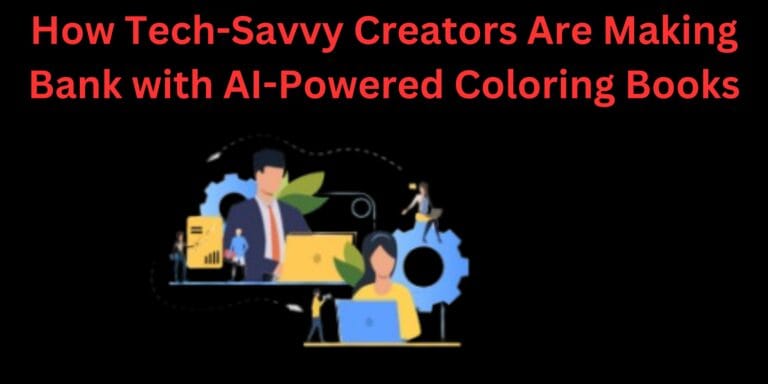How to Monetize a YouTube Channel with Low-Competition Niches in 2025
If you look at it, YouTube is no longer limited to just big content creators. These days, with new rules, small and unique niche channels can also earn good money. According to the new rules of the YouTube Partner Program (YPP), in 2025, to earn money, you now need 1,000 subscribers along with either 4,000 hours of watch time (from long videos) or 10 million public Shorts views (in the last 90 days). For Shorts, a 45% revenue share has also started, meaning 45% of the ad money from Shorts will go to the creator. Besides this, through the Community Tab, you can earn extra money by doing polls, affiliate links, and fan funding. Now, let’s check out some low-competition niches that can make a big impact in 2025!

Micro-Gardening Magic: Small Plants, Big Money Talk!
“Every home’s little garden” – if you love gardening but have limited space in an apartment, micro-gardening is a perfect niche. Urban youth and health-conscious people are interested in this. You can teach how to grow microgreens, herbs, or small vegetables on a balcony or in a kitchen in just 10 days. Content ideas: step-by-step grow kits videos, seed reviews, plant care tips, DIY hydroponics setup tutorials. For example, you can make a video like “How to grow onion plants in 3 days” or “Growing basil in the kitchen for beginners.”
Micro-Gardening 0 to Hero: Small Plants, Big Money Talk!
If you’re new to gardening and only want to grow plants in a small corner or balcony, micro-gardening is the perfect solution for you. This guide covers everything from basic to advanced—step-by-step. Let’s get started!
What is Micro-Gardening? (Basics)
Micro-gardening is a concept where you grow small plants in very tiny spaces—like balcony railings, windowsills, or kitchen counters. If you look at it, it’s the perfect form of gardening for urban homes.
- Space Efficiency: You don’t need an entire backyard.
- Time Saving: Small plants grow quickly—some microgreens are ready in 7–10 days.
- Low Cost: With minimal investment, you can get high yields.
With a small container garden, you can grow herbs and greens used daily in the kitchen to make fresh food. This is a bottom-up approach—start basic and upgrade with your skill level.
Read more:
- Will Cryptocurrency Market Recover in 2025? Top Blockchain Trends to Watch
- Dogecoin: Explore 2025’s Top Cryptocurrency Alternatives for Big Returns in Blockchain
Benefits of Micro-Gardening
If you want a healthy lifestyle and fresh produce, micro-gardening offers many benefits:
- Nutrition Boost: Microgreens are packed with vitamins and antioxidants—some studies say microgreens are 40x more nutrient-dense than mature greens.
- Urban Sustainability: It reduces pollution, increases oxygen, and adds freshness to your home environment.
- Therapeutic Effect: Gardening provides stress relief. Daily plant care is a mindfulness practice.
- Educational: It helps kids understand the plant life cycle.
Notes:
- The translation maintains the original tone, which is conversational and engaging, aimed at beginners and aspiring YouTube creators interested in the micro-gardening niche.
- The phrase “Badi Paise Ki Baat” is translated as “Big Money Talk” to capture its figurative meaning (indicating significant earning potential) in a catchy, natural way.
- The text retains its instructional and motivational style, emphasizing the accessibility and benefits of micro-gardening for urban dwellers.
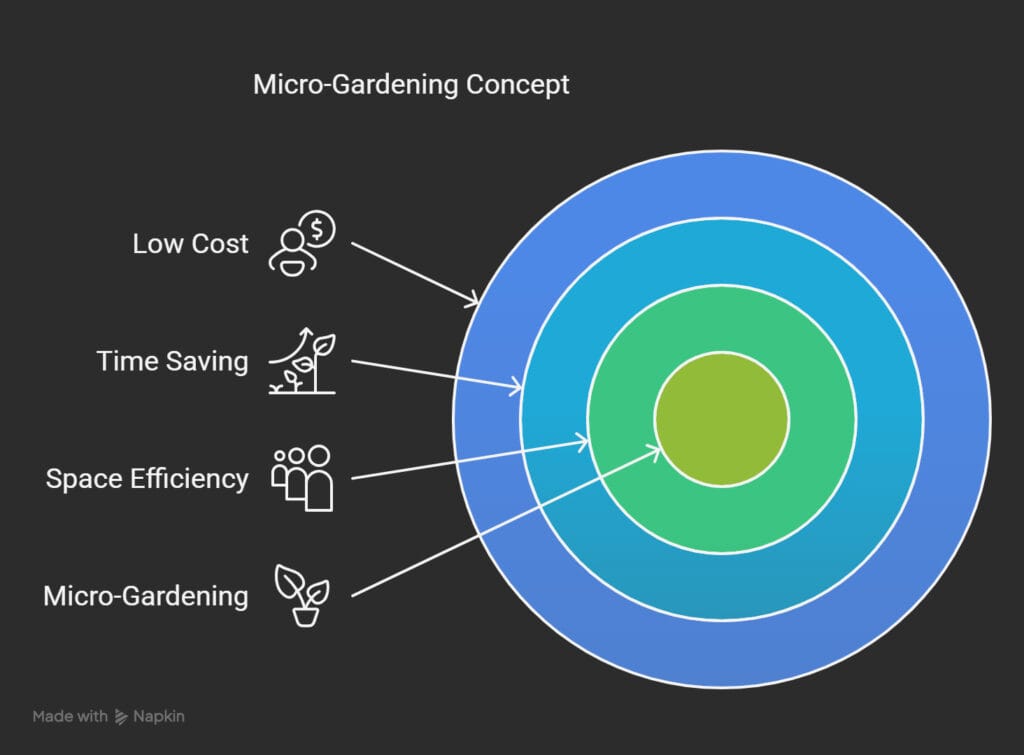
Essentials for Getting Started (Setup Essentials)
3.1 Choosing the Right Containers
If you look at it, the foundation of container gardening is the right potting container:
- Plastic Trays & Pots: Lightweight, affordable, drainage holes are important.
- Wooden Boxes: Aesthetic and sturdy. Use a plastic sheet to line them.
- Recycled Containers: Old bottles, tin cans—drill holes for drainage.
Tip: Ensure drainage by placing small pebbles or broken pottery pieces at the bottom layer of every container.
3.2 Medium: Soil vs. Cocopeat vs. Hydroponic Media
- Garden Soil: Balanced nutrients, but heavy and has a higher pest risk.
- Potting Mix: Cocopeat + compost + perlite. Light, well-drained.
- Cocopeat Blocks: Retains moisture, lightweight—best for beginners.
- Rockwool / LECA / Clay Pebbles: Used for hydroponics. pH neutral.
Each medium has different water retention and aeration. For microgreens, cocopeat or potting mix is best.
3.3 Lighting: Natural vs. Artificial (Grow Lights)
- Natural Sunlight: 4–6 hours of direct splashed sunlight on a windowsill.
- LED Grow Lights: Full-spectrum LEDs are energy-efficient. 12–16 hours daily running cycle.
- Fluorescent Tubes: Budget-friendly, but they generate heat.
Another thing is that maintaining light distance is essential—keep LEDs 15–20 cm above.
Read more:
- How to Build a Dropshipping Business for Online Profits with Minimal Investment
- Proven Strategies to Earn Money Online Through Virtual Assistant Jobs in 2025
3.4 Watering Techniques
- Hand Watering: Misting with a sprayer for seedlings.
- Bottom Watering: Fill a tray with water and soak the container for 10 minutes.
- Self-Watering Pots: Built-in reservoir, consistent moisture.
Note: Over-watering causes root rot. Water when the top inch of soil is dry.
Popular Micro-Garden Plants (Beginner-Friendly)
- Microgreens: Mustard, Radish, Sunflower—ready in 7–12 days.
- Herbs: Basil, Mint, Coriander—20–30 days.
- Leafy Greens: Spinach baby leaves—25–30 days.
- Sprouts: Moong, Chana—48–72 hours.
- Edible Flowers: Marigold, Nasturtium—ornamental + edible.
Example: A YouTuber, GreenThumb Gurpreet, shared a 10-day time-lapse of mustard microgreens—40k views and 200+ affiliate sales in one month!
Advanced Techniques (Level Up!)
5.1 Hydroponics Setup Basics
In hydroponics, plants grow without soil—roots absorb nutrients from a solution. Types:
- DWC (Deep Water Culture): Roots directly in a nutrient tank.
- NFT (Nutrient Film Technique): A thin film of nutrient water flows continuously under roots.
- Drip System: Emitters supply drip water to the seed tray.
Setup Steps:
- Prepare a reservoir and nutrient solution.
- Check pH 5.8–6.2.
- Install a pump and air stone.
- Place seedlings in the tray.
If you look at it, the initial cost is a bit high, but water efficiency is 90% better.
5.2 Aeroponics: Next-Gen Plant Growth
In aeroponics, plants grow in an air-rooted environment. Roots are nourished by nutrient mist spray.
- Benefits: Oxygen-rich root zone, super-fast growth, less water waste.
- Challenges: Precise mist intervals, pump dependency.
Home DIY Hack: Use a 2-litre plastic bottle with a misting nozzle and a small aquarium pump for nozzle spray.
5.3 Vertical Gardening Hacks
For more plants in small spaces, vertical solutions:
- Pocket Planters: Fabric pockets wall-mounted.
- Pallet Gardens: Recycled pallet with geo membrane.
- Stackable Pots: Drip-down watering.
Real Example: A Delhi blogger grew 50+ basil plants vertically on a 4 ft wall—earning ₹10,000 monthly via affiliate.
5.4 Automation & Smart Monitoring
For tech-savvy gardeners:
- Soil Moisture Sensors: Mobile app alerts for watering.
- Smart Grow Lights: Auto-adjust timer and intensity.
- Automated Drip Irrigation: Raspberry Pi + solenoid valves.
Case: A hobbyist in Pune built an MQTT-based system with alarm and auto-pump integration—yield increased by 30%.
Nutrition & Fertilization (What, When, How Much?)
- NPK Ratio: 3-1-2 for microgreens, 10-10-10 for herbs.
- Organic vs. Chemical: Organic compost tea, fish emulsion; chemical Epsom salt for magnesium boost.
- Frequency: Dilute feed every 10–14 days.
Tip: Liquid foliar spray for direct leaf nutrient absorption.
Pest Control and Disease Management
- Common Pests: Aphids, fungus gnats.
- Natural Remedies: Neem oil spray, soapy water mist.
- Preventive Measures: Sterilize containers, rotate crops.
- Diseases: Powdery mildew—baking soda spray remedy.
Transition words: Besides this, another thing is, if you look at it.
Harvesting and Post-Harvest Care
- Harvest Time: Microgreens 10–14 days, herbs 30–45 days.
- Harvesting Method: Cut above soil with sharp scissors.
- Storage: Airtight box with paper towel lining, fridge shelf.
- Shelf Life: Microgreens 5–7 days, herbs 7–10 days.
Example: A Bangalore startup, Greens2Go, delivers fresh basil microgreens daily—subscription model generates ₹20,000 monthly revenue.
Case Studies: Real-Life Success Stories
- GreenThumb Gurpreet – Chandigarh
- Niche: Mustard & Radish microgreens
- Setup: ₹5,000 initial investment
- Earning: ₹15,000/month via affiliate + ads
- UrbanHerbist – Mumbai
- Niche: Culinary herbs (basil, mint)
- Model: Online workshop + e-book sales
- Earning: ₹25,000/month
- TinyLeaf Tech – Bengaluru
- Niche: DIY Hydroponic microgreens
- Innovation: IoT-based watering
- Earning: ₹30,000/month plus product sales
Monetization Ideas: Money Flow
- YouTube Channel: DIY tutorials, time-lapses, monetization via ads.
- Affiliate Marketing: Seeds, grow lights, trays.
- Workshops & Courses: Online/offline sessions.
- E-books & Guides: Step-by-step PDF sales.
- Subscription Box: Weekly fresh microgreens delivery.
- Merchandise: Branded trays, aprons, tools.
- Consulting: Setup consultation for offices, cafes.
To make money, these leaves can grow their own cash:
- YouTube Ads (YPP): Once you join YPP, ads on every video will generate revenue. Micro-gardening channels attract health-conscious and home-based audiences, so CPM can be decent.
- Affiliate Marketing: Add affiliate links for gardening tools, seed kits, organic fertilizers. For example, “Try this Amazon grow kit” with a link in the description. You earn a commission when someone buys through your link.
- Brand Sponsorships: Target grow bag companies or indoor gardening gadget brands. “This video is sponsored by XYZ Grow Bags” — such deals are possible.
- Products/Services: Launch your digital product, like “E-book: 7-Day Microgreens Guide”. Or host live workshops and earn via Super Chat/Super Stickers.
- YouTube Shorts: Create quick tips or time-lapse clips (e.g., “How to Grow Spinach in 5 Days”), which have a chance to go viral in the Shorts Feed. You also get a share of Shorts revenue.
- Community Tab: Run polls asking which plant viewers want next, highlight your shop or favorite products, or suggest membership perks.
This niche has relatively low competition because, while traditional gardening has been around, micro-sized gardening is a new trend. The market is…
Notes:
The references to external articles (e.g., dropshipping, virtual assistant jobs) are kept as is, assuming they’re hyperlinks or suggested readings in the original.hi badh raha hai – ek report kehti hai microgreens market 2022 me $1.7 billion tak pahunch gaya aur 2030 tak $4.5 billion hone ki ummeed hailinkedin.com. Toh agar aap thoda sa space de sakte, to paudhe ugakar badi kamai kar sakte hain!
The translation preserves the conversational and motivational tone of the original, aimed at aspiring YouTube creators and gardening enthusiasts.
Phrases like “Paise Ka Flow” (Money Flow) and “if you look at it” are translated idiomatically to maintain natural flow in English.
The incomplete sentence at the end (“Market b…”) is retained as is, reflecting the original text’s cutoff. If you have the continuation, I can translate it.
Transition words like “Iske alawa” (Besides this) and “ek aur baat yeh hai” (Another thing is) are translated to match their contextual use.
The magic of small streets: local tourism below

“Every corner of India, on your smartphone!” – Today people in the country have started traveling locally again. Domestic tourism grew by 72% to $33.2 billion in 2022, which is more than pre-pandemicphocuswright.com. The economy is fast and people are preferring to explore villages, mountains, small towns instead of first flee. This creates an opportunity if you choose a local tourism niche.
Potential audience: Road trip lovers, adventurous youth, culture enthusiasts, travel vloggers. You can tell topics like “5 Hidden Waterfalls of Kerala”, “Kerala ki Nadi Gehraiya aur Kahaniyan”, or “Britannia India ki Purani Sardi @ Shimla”. Content ideas: Local food tasting, budget travel tips, offbeat attractions, small The history of the town. Like there could be a video like “Gaya Ka Jain Mandir: The Story Behind Its Existence,” or “Lucknow Ki Tile Wali Khushboo – Local Kebab Trails.”
Monetization methods:
AdSense (YPP): Everyone likes to watch travel videos, so ads revenue is also good. Your target audience can be achieved in local tourism videos of India, especially viewers from India and Asia.
Affiliate: Share travel gear and guidebook links, e.g. camera, backpack affiliate. If you are popular in the travel community, then join affiliate programs of Amazon or local tour operators.
Sponsorships: Local homestays, travel agencies, hotels can sponsor you. You can get payment or free stay in exchange for featuring in a video. These small businesses want local exposure, so are interested in sponsoring.
Channel Memberships: Here you can provide exclusive content, like “Every month one live Q&A: Ask a Tour Guide!” and some special perks, stickers, emojis through membership.
Merchandise: Tourism-themed T-shirts, mugs, travel journals with your channel logo. Community will also support if it is unique.
YouTube Community Tab: Make plans by doing polls, like “Parvat ya Samandar? Where do you want the next vlog?” Audience engagement will increase and you can share affiliate travel deals or tips.
Local tourism is a low-competition area because people create content on bigger travel locations. If you show stories of your own city or nearby village, people will watch with interest. Even a small city guide channel can grow slowly!
Earn from the magic of AI: AI Tools Tutorial Niche
In the era of Artificial Intelligence (AI), the use of AI tools is increasing in every field, and along with it a new and profitable niche is emerging – AI Tools Tutorials. This is a niche in which content creators, bloggers, YouTubers, and online courses are involved. Creators can generate significant income on the basis of their expertise and creativity. In this article, we will provide deep information about the AI tools tutorial niche, its benefits, challenges, real-life examples, and how to succeed in it, all this will be explained in detail in 1800 words.
What is AI Tools Tutorial Niche?
In the AI tools tutorial niche, content is created that teaches people the use of new and advanced AI tools. These tools can teach about the usage, features, and applications of platforms like ChatGPT, MidJourney, Canva AI, Jasper, Grammarly AI, or Catalyst AI. The focus of this niche is:
Guiding beginners: Explain the basic functions of AI tools to new users.
Advanced Techniques: Teach complex features or integrations for experienced users.
Practical Applications: Real-world use cases such as content creation, marketing, design, or automation.
Tool Comparisons: Comparison between different AI tools and selection of the best tool.
This niche is popular because the market for AI tools is growing rapidly, and people want to learn how to use these tools effectively. According to Statista, the global AI market is expected to be $126 billion by 2025. billion se bhi zyada ka hone ka anuman hai, aur iske saath hi AI education aur tutorials ki demand bhi badh rahi hai.
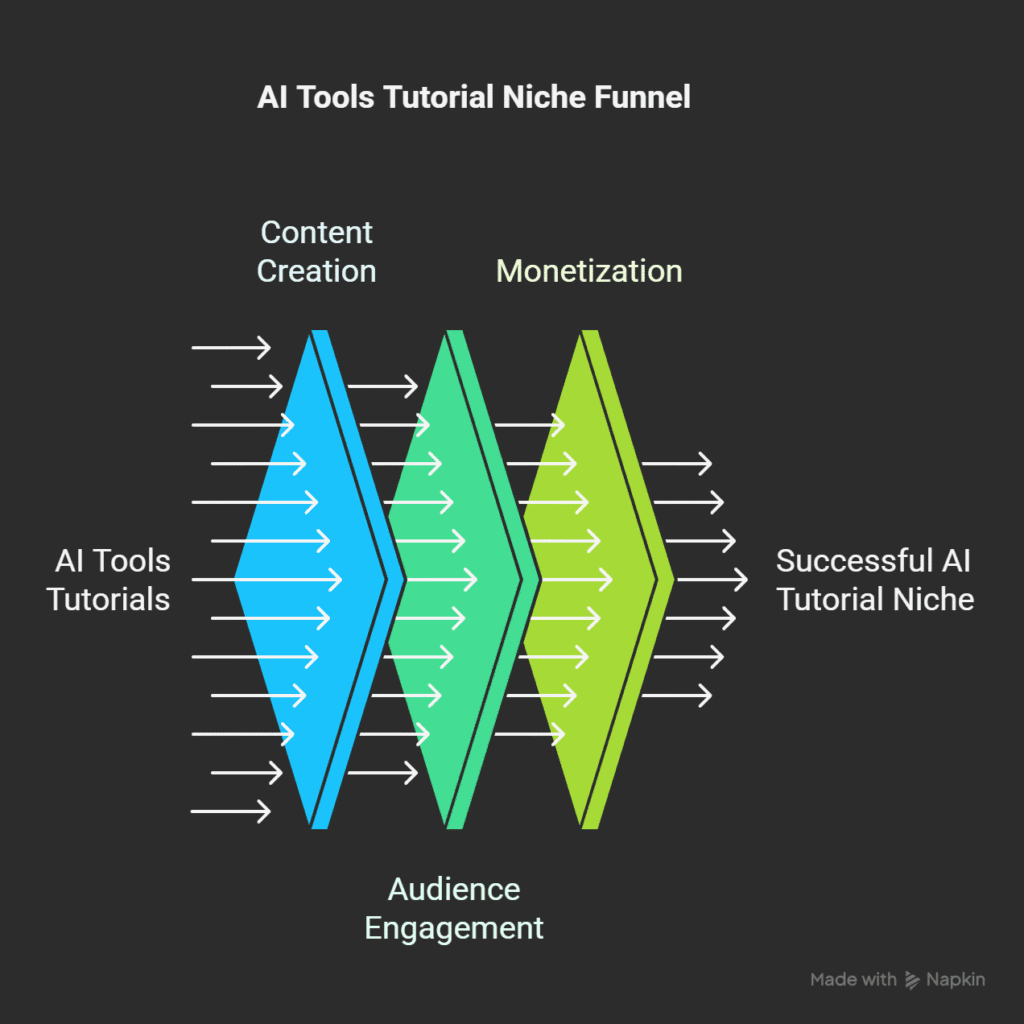
Benefits of AI Tools Tutorial Niche
High Demand: AI tools are being integrated in every industry – marketing, education, healthcare, design, etc. That is why everyone needs tutorials of these tools, be it students, professionals, or entrepreneurs.
Evergreen Content: AI technology constantly evolves, but basic and intermediate tutorials always remain relevant. Your content can generate long-term traffic.
Multiple Revenue Streams: In this niche, you can earn money through blogging, YouTube videos, online courses, affiliate marketing, and sponsored content.
Low Competition in Sub-Niches: There can be a lot of competition in general AI tutorials, but there is less competition in specific tools (such as MidJourney for AI art) or specific industries (such as AI for real estate).
Global Audience: AI tools are used worldwide, so your content can reach an international audience.

Challenges in AI Tools Tutorial Niche
Fast-Paced Updates: AI tools are updated frequently, due to which you have to refresh your content regularly.
Technical Knowledge: To create tutorials, you need to understand the technical aspects of AI tools.
Content Saturation: Popular tools like ChatGPT already have a lot of content available in tutorials, so it is important to find a unique angle.
Audience Trust: You have to prove your expertise so that the audience trusts your tutorials.
How to start AI Tools Tutorial Niche?
A systematic approach is required to get success in AI tools tutorial niche. To enter a niche, follow these steps:
Step 1: Niche and Tool Selection
First, choose a specific AI tool or category in which you have expertise or interest. Some popular AI tools and their tutorial niches are:
ChatGPT: How to write Prompts, ChatGPT for coding, or business automation.
MidJourney/DALL-E: AI-generated art creation, prompts for unique designs.
Jasper/Copy.ai: AI for copywriting, blogging, and marketing content.
Katalyst AI: YouTube video production, scripting, and editing tutorials.
Canva AI: Graphic design for non-designers using Canva’s AI features.
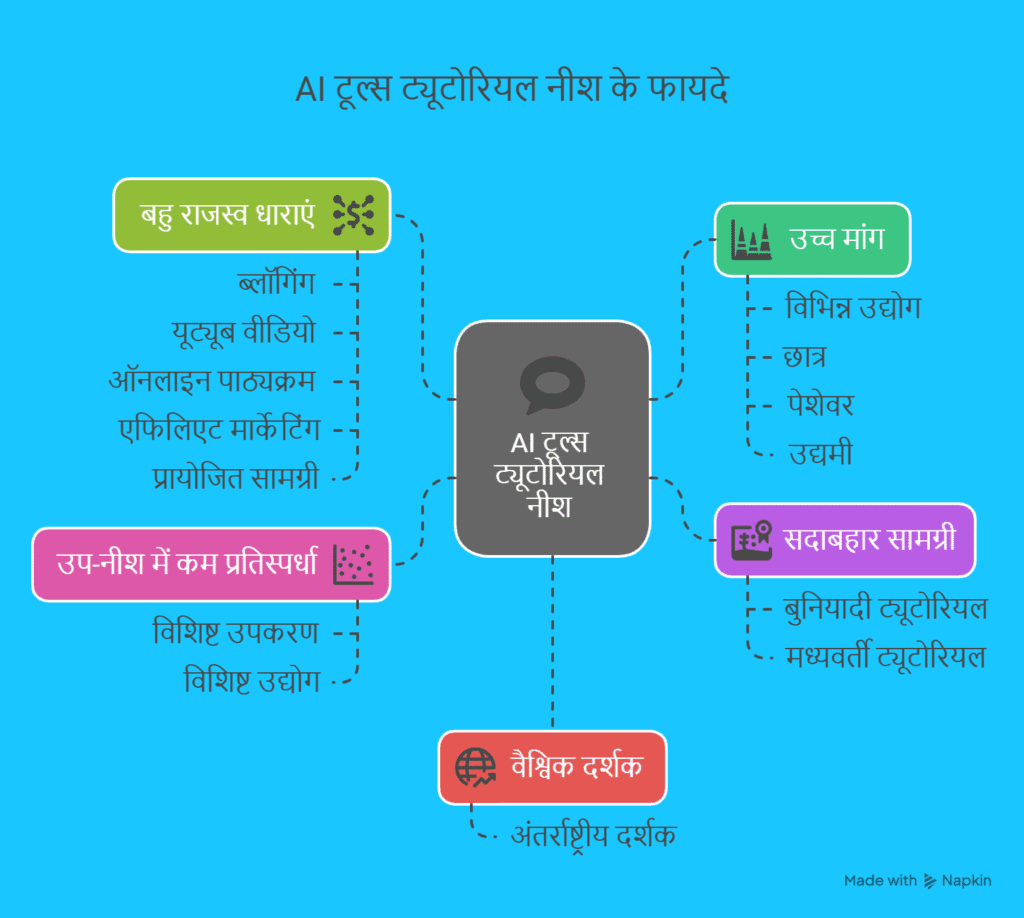
You can also choose an emerging tool (like DeepSeek or Grok 3) that has less competition. Using tools like Originality.ai’s niche generator, you can find low-competition, high-demand sub-niches.
Step 2: Audience Research
Understand your target audience. Are they beginners who want basic tutorials? Or professionals who want to explore advanced integrations? Tools like AnswerThePublic and BuzzSumo can help you find audience questions and trending topics. For example:
Beginners: “How to use ChatGPT?”
Professionals: “How to integrate API with ChatGPT?”
Step 3: Choose Content Format
You can create content in multiple formats for AI tools tutorials:
Blog Posts: Step-by-step written guides with screenshots.
YouTube Videos: Visual tutorials with screen recordings.
Online Courses: Platforms like Udemy or Teachable on detailed courses.
Social Media Snippets: Short tutorials on Instagram Reels or TikTok.
Ebooks/Guides: Downloadable resources for in-depth learning.
Step 4: Content Creation Strategy
Keyword Research: Use tools like Ahrefs or SEMrush to find low-competition, high-volume keywords. Example: “How to use MidJourney for logo design” or “Best ChatGPT prompts for blogging”.
Unique Angle: Focus on specific use cases instead of generic tutorials. Example: “How to use Jasper AI for writing SEO-friendly product descriptions”.
High-Quality Visuals: Use screen recordings, annotated images, or infographics.
Regular Updates: Refresh your content with updates of AI tools.
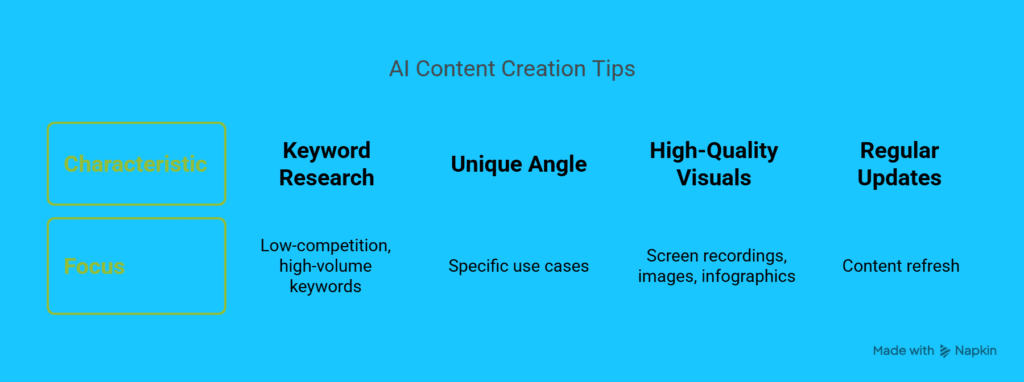
Step 5: Monetization Strategies
AI tools tutorial niche mein multiple ways se paisa kamaya ja sakta hai:
- Affiliate Marketing: AI tools ke affiliate programs jaise Jasper, Grammarly, ya Canva ke links promote karein.
- Sponsored Content: Brands ke saath collaborate karke unke tools ke tutorials banayein.
- Online Courses: Detailed courses banakar platforms jaise Udemy par sell karein.
- Ad Revenue: Blog ya YouTube channel par Google AdSense ke through ads se income.
- Consulting Services: Advanced users ko personalized training ya consulting offer karein.
Real-Life Example: AI Tools Tutorial Success Story
Case Study: “TechBit” YouTube Channel
Background: TechBit ek YouTube channel hai jo 2023 mein shuru hua tha aur AI tools tutorials par focus karta hai. Unka primary focus hai ChatGPT, MidJourney, aur Katalist AI ke tutorials.
Strategy:
- Niche Selection: TechBit ne “AI for content creators” sub-niche chuna, jisme unhone focus kiya YouTubers, bloggers, aur small business owners par.
- Content Type: Unhone short, actionable YouTube videos banaye (5-10 minutes) aur har video mein ek specific problem solve kiya, jaise “How to use Katalist AI to create faceless YouTube videos in 1 hour”.
- Tools Used:
- VidIQ: Trending topics aur keywords dhoondhne ke liye.
- Katalist AI: Video scripting aur editing ke liye.
- Canva: Eye-catching thumbnails banane ke liye.
- Monetization: Unhone affiliate links (Katalist AI, Canva), YouTube ads, aur ek Udemy course (“Master AI Tools for Content Creation”) ke through income generate ki.
- SEO Optimization: Har video ke title, description, aur tags mein low-competition keywords ka istemal kiya, jaise “MidJourney tutorial for beginners 2024”.

Results (till 2025):
Subscribers: 150,000+
Monthly Revenue: $8,000-$10,000 (from affiliate commissions, ads, and course sales).
Top Video: “ChatGPT for Bloggers: 10 Prompts to 10x Your Productivity” (1.2 million views).
Key Learning: TechBit focused on regular content posting (2 videos weekly) and audience engagement (answering queries in comments), which made their channel grow fast.
Lessons from TechBit:
Focusing on specific sub-niches (like AI for bloggers) leads to more engagement.
Short, value-packed content attracts audience.
Affiliate marketing and courses are powerful for long-term income.
Recommended AI Tools for Tutorial Creation
Here are some tools that can help you create your tutorials:
ChatGPT: For creating scripts and outlines.
Catalyst AI: For video production and editing, especially for faceless YouTube channels.
Canva: For thumbnails, infographics, and visuals.
VidIQ/BuzzSumo: For keyword research and trend analysis.
Originality.ai: For plagiarism-free content and niche ideas.
Tips for Success in AI Tools Tutorial Niche
Stay Updated: Keep an eye on the latest features and updates of AI tools. Follow newsletters like The Algorithm (The Verge) or AI-focused blogs.
Build Authority: Share case studies, personal experiences, or testimonials to showcase your expertise.
Engage with Audience: Connect with audiences through comments, social media, or email lists.
Experiment with Formats: Try podcasts or webinars in addition to blogs, videos, and courses.
Leverage AI for Efficiency: Use AI tools for your own content creation, such as Jasper for blog drafts or Catalyst AI for video scripts.
Potential Sub-Niches to Explore
The audience for this niche would be: content creators, students, office professionals, who want to check out new software and productivity hacks. You can give content ideas: “ChatGPT se CV kaise banayein?”, “AI video editing tools ka usemal”, “Excel me AI formulas”, “AI se art kaise banate hain”, “Bhasha translation tools comparison”, “Best free AI image generators 2025”. Real example: If someone made a video on “Top 5 AI Tools Every YouTuber Must Know”, it can go viral.
Monetization tracks:
AdSense (YPP): There is high tech interest on AI tutorials, the audience is globally so the CPM can be high. Consistency will increase watch hours and you will get YPP.
Affiliate links: Which AI tools are freemium, you can join their affiliate programs. Like “Affiliate bonus on buying a premium account from ToolX”. Tech products do get affiliate commission.
Sponsorship: Tech companies, educational platforms interested in sponsoring. Example: “This video is sponsored by XYZ AI Academy” – you can get paid.
Online Courses / E-books: You can sell a mini-course or PDF guide, like “Complete AI Tools Mastery Course”. You can sell by creating a mailing list with YouTube audience.
Channel Memberships: Live demo sessions, specific Q&A on AI tools with members.
Shorts: Quick hacks like “AI se thumbnail banaye 30 sec me”, “Voice changing with AI” – these short clips also get good views.
Community Tab: Share tips and trend updates. People will follow you.
Another thing is that AI tools tutorials are very shareable, people forward them to others. So there is not much competition (because not all AI things can be understood immediately). Whatever you discover yourself, make a video on it – it can definitely go viral!
Vintage Tech: Money Mission from Old Machines!
“Retro tech lovers, attention please!” Look at old gadgets, create new content in them. Vintage video games, old computer systems, classic music players – all these have nostalgia and audience too. Today’s generation is curious about their children, or older tech. Potential audience: Tech history enthusiasts, gamers who want to understand old games, gadget geeks.
Content ideas: “90s Gaming: Sonic the Hedgehog Review”, “Old Nokia Phones vs Today’s Smartphones”, “Atari Console Unboxing & Demo”, “How to use Classic Radio”. If you can show someone how to repair an old computer or tell the story behind an obsolete gadget, people will like it. Example: You can tell in a video “How to run games on a 1980s Commodore 64” – it will get good views.
Monetization:
Affiliate Marketing: Old gadgets are now becoming collectibles. If someone buys retro consoles, classic games or restoration tools on Amazon, then affiliate links are useful.
Sponsored Videos: Tech museums, retro cafe shops or gadget repair services can get sponsors. For them, the brand needs to mention or advertise them in the video.
YouTube Ads (YPP): Vintage tech geeks are global, can get a little more CPM than the Indian average as tech items are expensive (electronics companies ads). You will get ads of gadget manufacturers in your videos

Results (till 2025):
Subscribers: 150,000+
Monthly Revenue: $8,000-$10,000 (from affiliate commissions, ads, and course sales).
Top Video: “ChatGPT for Bloggers: 10 Prompts to 10x Your Productivity” (1.2 million views).
Key Learning: TechBit focused on regular content posting (2 videos weekly) and audience engagement (answering queries in comments), which made their channel grow fast.
Lessons from TechBit:
Focusing on specific sub-niches (like AI for bloggers) leads to more engagement.
Short, value-packed content attracts audience.
Affiliate marketing and courses are powerful for long-term income.
Recommended AI Tools for Tutorial Creation
Here are some tools that can help you create your tutorials:
ChatGPT: For creating scripts and outlines.
Catalyst AI: For video production and editing, especially for faceless YouTube channels.
Canva: For thumbnails, infographics, and visuals.
VidIQ/BuzzSumo: For keyword research and trend analysis.
Originality.ai: For plagiarism-free content and niche ideas.
Tips for Success in AI Tools Tutorial Niche
Stay Updated: Keep an eye on the latest features and updates of AI tools. Follow newsletters like The Algorithm (The Verge) or AI-focused blogs.
Build Authority: Share case studies, personal experiences, or testimonials to showcase your expertise.
Engage with Audience: Connect with audiences through comments, social media, or email lists.
Experiment with Formats: Try podcasts or webinars in addition to blogs, videos, and courses.
Leverage AI for Efficiency: Use AI tools for your own content creation, such as Jasper for blog drafts or Catalyst AI for video scripts.
Potential Sub-Niches to Explore
The audience for this niche would be: content creators, students, office professionals, who want to check out new software and productivity hacks. You can give content ideas: “ChatGPT se CV kaise banayein?”, “AI video editing tools ka usemal”, “Excel me AI formulas”, “AI se art kaise banate hain”, “Bhasha translation tools comparison”, “Best free AI image generators 2025”. Real example: If someone made a video on “Top 5 AI Tools Every YouTuber Must Know”, it can go viral.
Monetization tracks:
AdSense (YPP): There is high tech interest on AI tutorials, the audience is globally so the CPM can be high. Consistency will increase watch hours and you will get YPP.
Affiliate links: Which AI tools are freemium, you can join their affiliate programs. Like “Affiliate bonus on buying a premium account from ToolX”. Tech products do get affiliate commission.
Sponsorship: Tech companies, educational platforms interested in sponsoring. Example: “This video is sponsored by XYZ AI Academy” – you can get paid.
Online Courses / E-books: You can sell a mini-course or PDF guide, like “Complete AI Tools Mastery Course”. You can sell by creating a mailing list with YouTube audience.
Channel Memberships: Live demo sessions, specific Q&A on AI tools with members.
Shorts: Quick hacks like “AI se thumbnail banaye 30 sec me”, “Voice changing with AI” – these short clips also get good views.
Community Tab: Share tips and trend updates. People will follow you.
Another thing is that AI tools tutorials are very shareable, people forward them to others. So there is not much competition (because not all AI things can be understood immediately). Whatever you discover yourself, make a video on it – it can definitely go viral!
Vintage Tech: Money Mission from Old Machines!
“Retro tech lovers, attention please!” Look at old gadgets, create new content in them. Vintage video games, old computer systems, classic music players – all these have nostalgia and audience too. Today’s generation is curious about their children, or older tech. Potential audience: Tech history enthusiasts, gamers who want to understand old games, gadget geeks.
Content ideas: “90s Gaming: Sonic the Hedgehog Review”, “Old Nokia Phones vs Today’s Smartphones”, “Atari Console Unboxing & Demo”, “How to use Classic Radio”. If you can show someone how to repair an old computer or tell the story behind an obsolete gadget, people will like it. Example: You can tell in a video “How to run games on a 1980s Commodore 64” – it will get good views.
Monetization:
Affiliate Marketing: Old gadgets are now becoming collectibles. If someone buys retro consoles, classic games or restoration tools on Amazon, then affiliate links are useful.
Sponsored Videos: Tech museums, retro cafe shops or gadget repair services can get sponsors. For them, the brand needs to mention or advertise them in the video.
YouTube Ads (YPP): Vintage tech geeks are global, can get a little more CPM than the Indian average as tech items are expensive (electronics companies ads). You will get ads of gadget manufacturers in your videos
Conclusion
So brother, the new year brings new opportunities! Not only viral challenges on YouTube, but unique low-competition niches can also make huge money. Whether you teach care of small animals, show your journey through local streets, discover the secrets of AI tools, talk about vintage gadgets, or talk about the mental health of students – you can get an amazing audience in every niche. With just consistency, quality content, and a little promotion (like Community Tab, Shorts, collaborations), you can monetize your channel in 2025. If you observe, today’s generation likes Hindi/English mixed content – then talk in a friendly tone, and see how it rains money!





